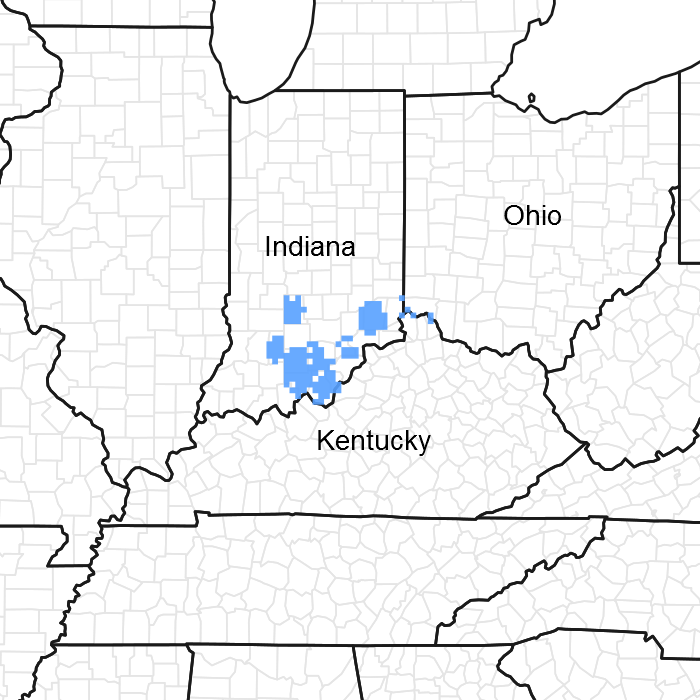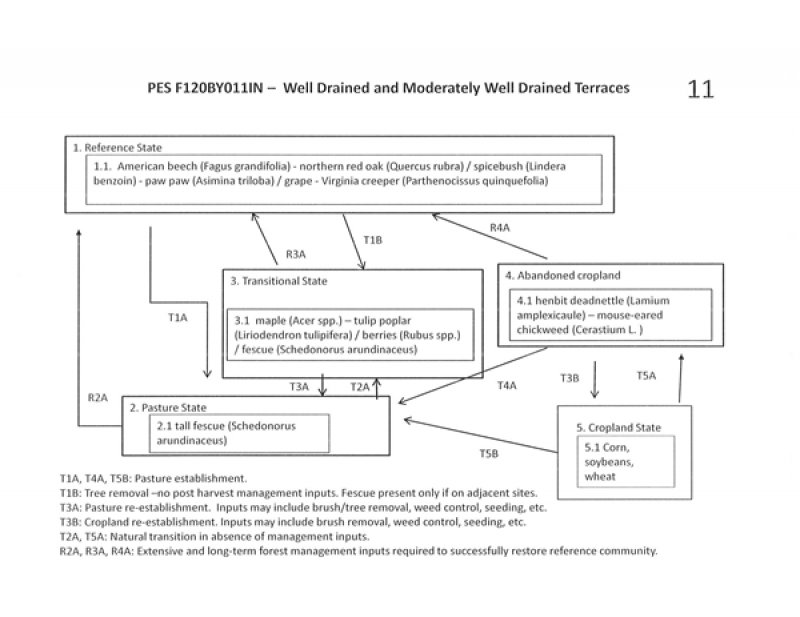
Natural Resources
Conservation Service
Ecological site F120BY011IN
Well Drained Terraces
Last updated: 10/01/2024
Accessed: 12/06/2025
General information
Provisional. A provisional ecological site description has undergone quality control and quality assurance review. It contains a working state and transition model and enough information to identify the ecological site.

Figure 1. Mapped extent
Areas shown in blue indicate the maximum mapped extent of this ecological site. Other ecological sites likely occur within the highlighted areas. It is also possible for this ecological site to occur outside of highlighted areas if detailed soil survey has not been completed or recently updated.
MLRA notes
Major Land Resource Area (MLRA): 120B–Kentucky and Indiana Sandstone and Shale Hills and Valleys, Northwestern Part
120B-Kentucky and Indiana Sandstone and Shale Hills and Valleys, Northwestern Part is located in Indiana and covers about 3,040 sq.mi. This area is in the Highland Rim Section of the Interior Low Plateaus Province of the Interior Plains. Tributaries of the Ohio River dissect the uplands. The major streams and rivers have well defined valleys with broad flood plains and numerous stream terraces. The geologic materials in this area are of Early and Middle Pennsylvanian and Late Mississippian age. The rocks consist mainly of flat-lying, interbedded sandstone, shale, coal, and siltstone with minor areas of limestone. Bedrock outcrops are common on river bluffs. The dominant soil orders in this MLRA are Alfisols, Ultisols, and Inceptisols. The soils in the area have a mesic soil temperature regime, a udic or aquic soil moisture regime, and dominantly mixed mineralogy. They formed dominantly in less than 40 inches of loess and in residuum or colluvium derived from sandstone, shale, and siltstone. The soils range from moderately deep to very deep and from poorly drained to somewhat excessively drained and are loamy, silty, or clayey. Fragiudalfs (Apalona, Zanesville) and Hapludalfs (Wellston) are the dominant soils on ridgetops and upper slopes. Hapludults (Adyeville) and Dystrudepts (Tipsaw) are on side slopes, and Hapludults (Tulip) are on footslopes. Hapludalfs (Deuchars, Ebal, Kitterman) are on structural benches and scarps. Endoaquepts (Zipp), Epiaqualfs (McGary), and Hapludalfs (Shircliff, Markland) are formed in lacustrine sediments. Hapludults (Millstone), Hapludalfs (Elkinsville), Fragiudalfs (Sciotoville), and Epiaqualfs (Hatfield) are on terraces along the Ohio River. Hapludolls (Huntington), Eutrudepts (McAdoo, Lindside), and Endoaquepts (Newark) are on flood plains along the major streams. Dystrudepts (Cuba, Steff), Eutrudepts (Gatchel, Haymond), Endoaquepts (Belknap, Stendal), and Fluvaquents (Birds, Bonnie) are on local flood plains.
Classification relationships
South Central Interior Mesophytic Forest
CES 202.887
Possible Association:
Fagus grandifolia - Acer saccharum - Liriodendron tulipifera Unglaciated Forest.CEGL002411. NatureServe.org summary of the community:
"This beech - maple forest is found in unglaciated areas of the east-central United States. Stands occur on unglaciated terraces and mesic slopes of maturely dissected plateaus and submontane regions. The aspect is neutral on sandy alluvial terraces and is northern to eastern on slopes. Soils are moderately well-drained, moist, rich and deep (100+ cm). The vegetation is dominated by a closed-canopy forest with a well-developed tall-shrub layer. The forest canopy is dominated by Fagus grandifolia and Acer saccharum. Other canopy species include Liriodendron tulipifera, Liquidambar styraciflua, Fraxinus americana, Quercus rubra, Carya glabra, and Carya cordiformis. Shrubs commonly found in this community are Asimina triloba and Lindera benzoin. Herbaceous species are diverse, forming a dense cover. They include Adiantum pedatum, Arisaema triphyllum, Asarum canadense, Carex blanda, Dicentra canadensis, Dioscorea quaternata, Galium circaezans, Menispermum canadense, Phegopteris hexagonoptera, Polystichum acrostichoides, and Sanguinaria canadensis. The large size of dominant canopy species (over 30 m tall), herbaceous diversity, and accumulated litter emphasize the high degree of mesophytism. Community occurrences have been extensively logged, and the canopy openings favor regeneration of Acer saccharum."
On smaller riparian segments, the American Beech - Oak species - Red Maple - Black Walnut Forest CEGL005014 may be more applicable: "This beech - hardwoods floodplain forest community is found in the central United States and adjacent Canada. Stands occur on high terraces of small stream floodplains. Soils are well-drained and at least partially alluvial in origin, flooding only occasionally."
These sites may also gradient into upland communities such as Fagus grandifolia - Acer saccharum - Liriodendron tulipifera Unglaciated Forest CEGL002411. Field work is needed to accurately determine community composition for these sites.
Ecological site concept
The Well Drained Terraces ecological sites occur on alluvium, very thin loess over alluvium and even include lakebeds in MLRA 12B. Representative soils include: Elk, Elkinsville, Elkinsville Variant, Markland, Martinsville, Millstone.
The communities described in this provisional document reflect plant communities that are likely to be found on these soils and have not been field verified. This PES describes hypotheses based on available data of many different scales and sources and has not been developed utilizing site-specific ecological field monitoring. This PES does not encompass the entire complexity or diversity of these sites. Field studies would be required to develop a comprehensive and science-based restoration plan for these sites.
State 1, Phase 1.1:
Forestland. Plant species dominant:
American beech (Fagus grandifolia) - northern red oak (Quercus rubra) / spicebush (Lindera benzoin) - paw paw (Asimina triloba) / grape - Virginia creeper (Parthenocissus quinquefolia)
Fagus grandifolia - Acer saccharum - Liriodendron tulipifera Unglaciated Forest.CEGL002411. NatureServe.org summary of the community:
"This beech - maple forest is found in unglaciated areas of the east-central United States. Stands occur on unglaciated terraces and mesic slopes of maturely dissected plateaus and submontane regions. The aspect is neutral on sandy alluvial terraces and is northern to eastern on slopes. Soils are moderately well-drained, moist, rich and deep (100+ cm). The vegetation is dominated by a closed-canopy forest with a well-developed tall-shrub layer. The forest canopy is dominated by Fagus grandifolia and Acer saccharum. Other canopy species include Liriodendron tulipifera, Liquidambar styraciflua, Fraxinus americana, Quercus rubra, Carya glabra, and Carya cordiformis. Shrubs commonly found in this community are Asimina triloba and Lindera benzoin. Herbaceous species are diverse, forming a dense cover. They include Adiantum pedatum, Arisaema triphyllum, Asarum canadense, Carex blanda, Dicentra canadensis, Dioscorea quaternata, Galium circaezans, Menispermum canadense, Phegopteris hexagonoptera, Polystichum acrostichoides, and Sanguinaria canadensis. The large size of dominant canopy species (over 30 m tall), herbaceous diversity, and accumulated litter emphasize the high degree of mesophytism. Community occurrences have been extensively logged, and the canopy openings favor regeneration of Acer saccharum."
State 2, Phase 2.1:
Pastureland.
Plant species dominant: Schedonorus arundinaceus (tall fescue). Species present are dependent upon seeding and management.
State: 3. Phase 3.1:
The transitional phase plant community composition will depend upon previous land uses – pasture type, management while in pasture (high quality pasture versus minimal managed grass-shrub –sapling community), and adjacent seed sources. State 3 listed below is assuming a transition from a fescue pasture. This phase is best described as an old field habitat with a mixture of native and introduced grasses and a variety of native and non-native herbs, forbs, seedlings, and saplings. Nearby available seed sources will greatly influence the makeup of this successional community.
Transitional (Abandoned Field)
Plant species dominant: maple (Acer spp.) – Tulip poplar (Liriodendron tulipifera) / berries (Rubus spp.)
/ giant ironweed (Vernonia gigantea) -fescue (Schedonorus arundinaceus)
State 4, Phase 4.1:
Abandoned Cropland
Plant species dominant: henbit deadnettle (Lamium amplexicaule) – mouse-eared chickweed (Cerastium L. )
Abandonment of cropland would result in many weed species taking over the site. Initially, annual weeds would be predominate followed by grasses, shrubs and pioneers trees.
State 5, Phase 5.1:
Cropland. Plant species dominants: dependent upon seeding and management.
Most common crops are corn and soybeans.
Restoration of states 2-5 to the reference community would require long-term, intensive management inputs.
Associated sites
| F120BY013IN |
Moist Terraces Moist Terraces |
|---|
Similar sites
| F120BY013IN |
Moist Terraces Moist Terraces |
|---|
Table 1. Dominant plant species
| Tree |
(1) Fagus grandifolia |
|---|---|
| Shrub |
(1) Lindera benzoin |
| Herbaceous |
(1) Vitis |
Click on box and path labels to scroll to the respective text.
